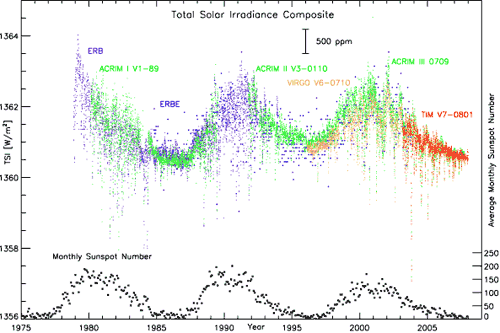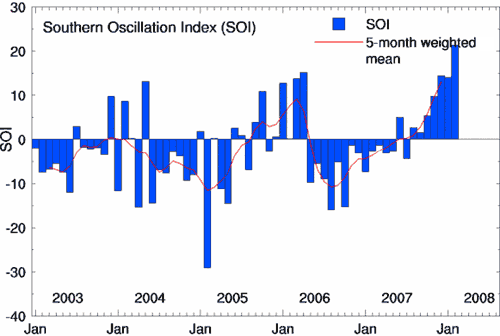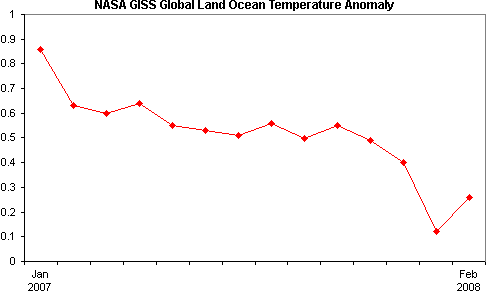
Figure 1: global temperature anomaly from HadCRUT (graph courtesy Anthony Watts).
A new argument is hurtling up the Skeptic Leaderboard, leaving old stalwarts like mid-century cooling and water vapor in its wake. The argument is that global warming has reversed and we're now undergoing global cooling. No, it's not the old chestnut global warming stopped in 1998. The new contention is that global warming stopped in January 2007.
The argument originated from Anthony Watts who plotted data from 4 sources (HadCRUT, GISS, RSS and UAH), all of which show sharp cooling of around 0.6°C from January 2007 to January 2008. The most common interpretation around the blogosphere is that the long term global warming trend has reversed. Daily Tech goes so far as to say 2007 "wipes out a century of warming".

Figure 1: global temperature anomaly from HadCRUT (graph courtesy Anthony Watts).
The flaw in this interpretation is in drawing conclusions about long term climate change over a relatively short period of 13 months. Particularly when a large portion of that cooling occured over one month (January 2008). Only over a period of years to decades can you confidently discern climate trends. Otherwise, you run the danger of mistaking weather for climate.
Nevertheless, several important questions remain - what's causing this sudden cooling and is it the start of a long term trend?
The general consensus among skeptic blogs is that diminished solar activity is the cause. The sun is currently at solar minimum - cycle 23 just ended and cycle 24 is having trouble kicking along. It's as cool as it gets in the solar cycle.
However, a temperature drop of 0.6°C would require a dramatic reduction in Total Solar Irradiance (TSI). According to theoretical calculations at Atmoz, TSI would need to fall to 1347.65 W/m2 to produce a global cooling of 0.6°C. In other words, 13 W/m2 less than current levels. This is ludicrously large considering the solar cycle varies only around 1.3 W/m2.
Alternatively, Camp 2007 adopts an empirical approach to calculate solar influence on global temperature. He determines the solar cycle contributes 0.18°C cooling to global temperatures as the sun moves from maximum to minimum. Note - this includes any influence due to cosmic rays as TSI closely correlates with the solar magnetic field which modulates cosmic radiation. Employing back of a napkin calculations, TSI would need to fall roughly 4.3 W/m2 to provide 0.6°C of cooling.
Either way, TSI needs to drop considerably to be considered the driver of 2007 cooling. So what has the sun been doing over the last few years?

Figure 2: TSI Composite and Sunspot Numbers (graph courtesy Greg Kopp).
Satellite measurements show no dramatic drop in TSI over the past several years. Instead, the solar cycle is following its usual 11 year cycle, flattening out as it reaches solar minimum. So if not the sun, what's causing the cooling?
Currently, the Pacific Ocean is in a La Niña phase. During La Niña, cold waters upwell to cool large areas of the equatorial Pacific Ocean. This has the effect of cooling the atmosphere. During the La Niña episode of 1999, global temperatures dropped around 0.5°C.
The Southern Oscillation Index (SOI) is a measure of La Niña. Positive SOI corresponds to a La Niña phase. In 2006, the Pacific Ocean was in El Niño phase (negative SOI). However, in late 2006, El Niño subsided and in mid 2007, crossed into La Niña phase. La Niña peaked around January 2008 and is the strongest La Niña since 1999. In the Eastern Pacific, sea-surface temperatures are about two degrees colder than normal over an area the size of the United States.

Figure 3: Southern Oscillation Index (graph courtesy bom.giv.au).
The UK Met Office predict the cooling effect of La Niña will be slightly greater in 2008 than it was during 2007. According to NOAA’s Climate Prediction Center, the current La Niña episode is expected to start weakening in February 2008. The moral of the story - don't use short term weather patterns to draw conclusions about long term climate trends. My prediction is the current global cooling trend will reverse around mid-2008 when La Niña subsides. That's a bit vague though - feel free to go out on a limb and post a comment with your own prediction of the following months.
Meanwhile, solar cycle 24 is expected to crank up later this year so over the next 5 years, the global warming trend will accelerate as increasing solar activity adds to CO2 warming. So enjoy the cold while it lasts. Personally, I'm strongly considering a skiing holiday.
Update 13 March 2008: NASA GISS have updated the Land Ocean Temperature Index. February 2008 shows a global temperature increase of 0.14°C from January 2008. Not as much as John Cross predicted but more than I expected - I thought La Nina cooling might continue for at least a few more months. Probably a bit early to say La Nina cooling has reversed though - will be interesting to see March's figures.

UPDATE 9 April 2008: I've updated the monthly temperature with March's data at La Nina watch: March update (also busied up the graph with Southern Oscillation Index data).
Posted by John Cook on Tuesday, 4 March, 2008
 |
The Skeptical Science website by Skeptical Science is licensed under a Creative Commons Attribution 3.0 Unported License. |